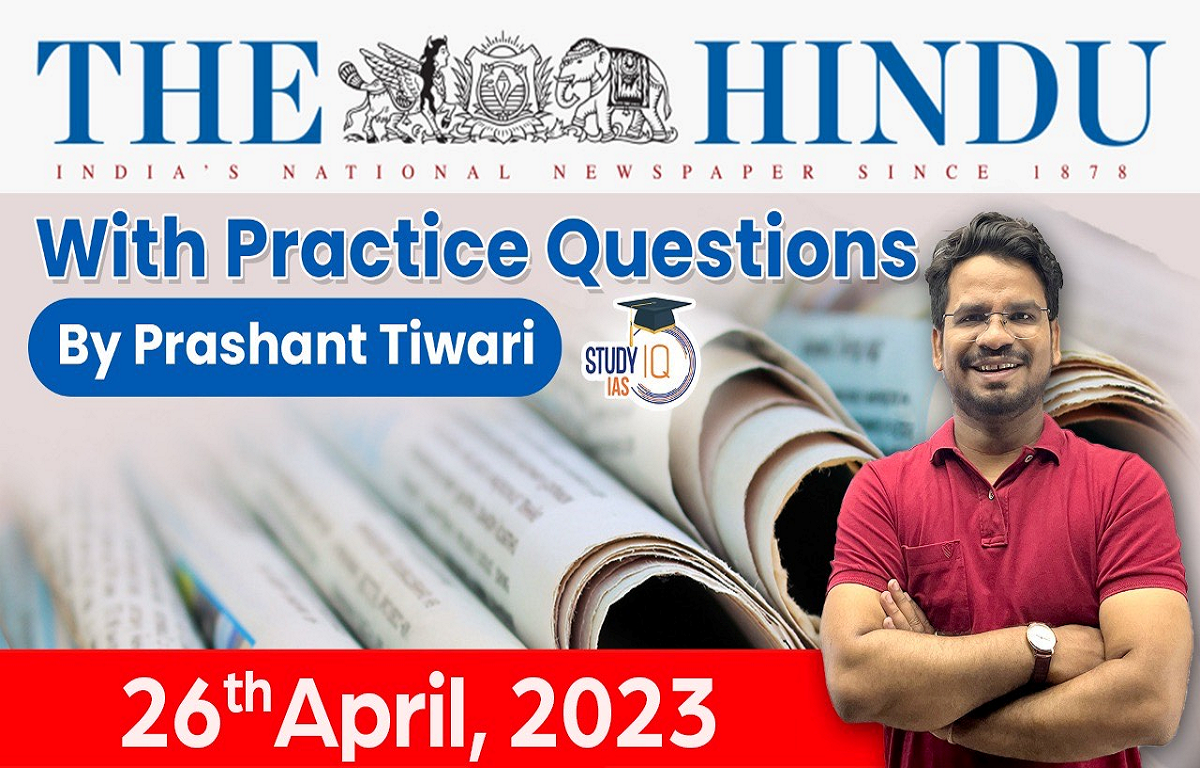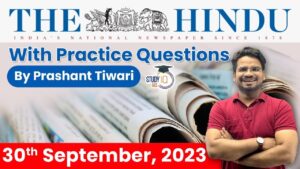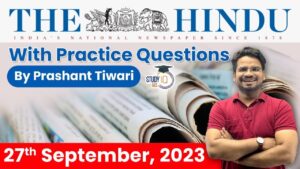The Hindu Newspaper Analysis for UPSC
- The Supreme Court on Tuesday stayed a Madras High Court’s decision to quash a 2018 notification banning gutkha and other tobacco products in Tamil Nadu.
- A Bench of Justices K.M. Joseph and B.V. Nagarathna said manufacturers were free to approach the appropriate forum in case they felt the notification did not cover their activities.
- Senior advocate Kapil Sibal and Additional Advocate General Amit Anand Tiwari, appearing for Tamil Nadu, argued that health was a State subject. It was the duty of the State government to look out for and take care of the health of the people of Tamil Nadu, Mr. Sibal said.
Tobacco Consumption in India
- In India, over 1.3 million deaths are attributable to tobacco use every year amounting to 3500 deaths per day, imposing a lot of avoidable socio-economic burden.
- In addition to the death and diseases, tobacco also impacts the economic development of the country.
- As per the WHO study titled “Economic Costs of Diseases and Deaths Attributable to Tobacco Use in India” it has been estimated that the economic burden of diseases and deaths attributable to tobacco use of tobacco in India was as high as Rs. 1.77 lakh crores, amounting to approx 1 per cent of Gross Domestic Product (GDP).

- Prime Minister Narendra Modi said only a strong government at the Centre could harness the power of States to spur national development.
- Cooperative federalism is the concept which reflects the relationship between centre and state where they both come together and resolve the common problems with each other’s’ cooperation.
- Separation of Power: Schedule 7 of Constitution provides strict delineation of powers between center and state. (Except during emergencies which comes under judicial review)
- Article 131 of the Constitution, which gives the Supreme Court exclusive jurisdiction to hear cases between states and the Centre.
Reason for a centralised federal structure in India
- Partition of India and the concomitant concerns: Anticipating the Muslim League’s participation in the Constituent Assembly debates following the Cabinet Mission plan in 1946, the Objectives Resolution introduced by Jawaharlal Nehru in the Assembly were inclined towards a decentralised federal structure. In it, the States would wield residuary powers.
- Safeguarding the integrity of the nation: After the Partition a revised stand was unanimously taken by the Union Powers Committee of the Constituent Assembly, in favour of a strong Union with residuary powers and weaker States, to safeguard the integrity of the nation.
- Helping India come out of social problems, a strong centre was important: Nehru and Ambedkar believed that a centralised federal structure would unsettle prevalent trends of social dominance, help fight poverty better and therefore yield liberating outcomes.
- Objective of building a welfare state: In a decentralised federal setup, redistributive policies could be structurally thwarted by organised (small and dominant) groups. Instead, a centralised federal set-up can prevent such issues and further a universal rights-based system.

- Justice G.R. Swaminathan of the Madras High Court said recently that B.R. Ambedkar wanted to make Sanskrit the official language of the Indian Union.
- It is true that on September 10, 1949, B.R. Ambedkar submitted an amendment in the Constituent Assembly that proposed Sanskrit as ‘the official language on the Union’. There were 16 signatories who included, apart from B.R. Ambedkar himself, T.T. Krishnamachari, Dr. P. Subbarayan, G. Durgabai, and Dakshayani Velayudhan. All signatories were from non-Hindi speaking provinces.
- The first is Granville Austin’s classic, The Indian Constitution: Cornerstone of a Nation, which first appeared in 1966. And the second is B. Shiva Rao’s magisterial The Framing of India’s Constitution that was published in 1968.
- Eighth Schedule:
- It lists the official languages of the republic of India. Part XVII of the Indian constitution deals with the official languages in Articles 343 to 351.
- The Constitutional provisions related to the Eighth Schedule are:
- Article 344: Article 344(1) provides for the constitution of a Commission by the President on expiration of five years from the commencement of the Constitution.
- Article 351: It provides for the spread of the Hindi language to develop it so that it may serve as a medium of expression for all the elements of the composite culture of India.
Official Languages:
- The Eighth Schedule to the Constitution consists of the following 22 languages:
- Assamese, Bengali, Gujarati, Hindi, Kannada, Kashmiri, Konkani, Malayalam, Manipuri, Marathi, Nepali, Oriya, Punjabi,Sanskrit, Sindhi, Tamil, Telugu, Urdu, Bodo, Santhali, Maithili and Dogri.
- Of these languages, 14 were initially included in the Constitution.
- Sindhi language was added by the 21st Amendment Act of 1967.
- Konkani, Manipuri, and Nepali were included by the 71st Amendment Act of 1992.
- Bodo, Dogri, Maithili, and Santhali were added by the 92nd Amendment Act of 2003 which came into force in 2004.
Classical Languages:
- Currently there are six languages that enjoy the ‘Classical’ status in India:
- Tamil (declared in 2004), Sanskrit (2005), Kannada (2008), Telugu (2008), Malayalam (2013), and Odia (2014).
- All the Classical Languages are listed in the Eighth Schedule of the Constitution.
Guidelines:
- The Ministry of Culture provides the guidelines regarding Classical languages which are as given below:
- High antiquity of its early texts/recorded history over a period of 1500-2000 years;
- A body of ancient literature/texts, which is considered a valuable heritage by generations of speakers.
- The literary tradition is original and not borrowed from another speech community.
- The classical language and literature being distinct from modern, there may also be a discontinuity between the classical language and its later forms or its offshoots.

- India will host Defence Ministers from the Shanghai Cooperation Organisation (SCO) grouping, including China’s Li Shangfu and Russia’s Sergei Shoigu, later this week, India’s Ministry of Defence said on Tuesday.
- As Chair this year of the SCO, which includes Russia, China, Kazakhstan, Kyrgyzstan, Tajikistan, Uzbekistan and Pakistan besides India, New Delhi will be hosting the visiting Defence Ministers from member countries, as well as from observers Belarus and Iran.
- While Pakistan Defence Minister Khawaja Asif is expected to join the conference virtually, a Pakistani Defence Ministry delegation arrived in India on Tuesday for the SCO Working Group meeting on Wednesday, ahead of the Ministerial meeting.
- Prior to the creation of SCO in 2001, Kazakhstan, China, Kyrgyzstan, Russia and Tajikistan were members of the Shanghai Five.
- Shanghai Five (1996) emerged from a series of border demarcation and demilitarization talks which the four former Soviet republics held with China to ensure stability along the borders.
- Following the accession of Uzbekistan to the organisation in 2001, the Shanghai Five was renamed the SCO.
- India and Pakistan became members in 2017.
- Current Members: Kazakhstan, China, Kyrgyzstan, Russia, Tajikistan, Uzbekistan, India and Pakistan.
- Official Languages:
- Russian and Chinese.
Permanent Bodies:
- SCO Secretariat in Beijing.
- Executive Committee of the Regional Anti-Terrorist Structure (RATS) in Tashkent.
Chairmanship:
- It is by rotation for a year by Member States.
Q) Talle Wildlife Sanctuary, which was recently in the news, is located in which state?
- Arunachal Pradesh
- Uttar Pradesh
- Maharashtra
- None of these
हाल ही में सुर्ख़ियों में रहा टाल वन्यजीव अभ्यारण्य किस राज्य में स्थित है?
- अरुणाचल प्रदेश
- उत्तर प्रदेश
- महाराष्ट्र
- इनमें से कोई नहीं
Explanation :
Recently, researchers from Titli Trust, National Centre for Biological Sciences and others have discovered a new moth from Talle Wildlife Sanctuary in Arunachal Pradesh.
- Piarosoma arunachalensis is a moth species belonging to the genus Piarosoma.
- The moth is a Burnet moth and is largely day-flying.
- It belongs to the family Zygaenidae, which includes Forester and Burnet moths.
- Burnet and Forester’s moths are brightly coloured day-flying moths, often with clubbed antennae.
- Moths are highly diverse organisms and scientists estimate there are 160,000 moth species in the world and about 12,000 species in India.
- Talle Wildlife Sanctuary is a wildlife sanctuary as well as a bio-diversity hotspot located in the state of Arunachal Pradesh.
- Rivers like Pange, Sipu, Karing and Subansiri flow through this sanctuary.
- Flora: It comprises sub-tropical and alpine forests.
- Fauna: Clouded leopard, Himalayan squirrel, Himalayan Black Bear etc.
Q) With reference to the 100 food streets in 100 Districts initiative, consider the following statements:
- It is an initiative of the Food Safety and Standards Authority of India.
- Under this initiative financial assistance of Rs.10 crore per food street/district will be provided.
Which of the above statements is/are correct?
- 1 only
- 2 only
- Both 1 and 2
- Neither 1 nor 2
100 जिलों में 100 फूड स्ट्रीट पहल के संदर्भ में निम्नलिखित कथनों पर विचार करें:
- यह भारतीय खाद्य सुरक्षा और मानक प्राधिकरण की एक पहल है।
- इस पहल के तहत प्रति फूड स्ट्रीट/जिला को 10 करोड़ रुपये की वित्तीय सहायता प्रदान की जाएगी।
उपरोक्त कथनों में से कौन-सा/से सही है/हैं?
- केवल 1
- केवल 2
- 1 और 2 दोनों
- न तो 1 और न ही 2
Explanation :
Recently, the Union Ministry of Health and Family Welfare in collaboration with the Ministry of Housing & Urban Affairs has requested states/UTs to develop 100 food streets in 100 districts across the country.
- This project aims to encourage safe and healthy food practices among food businesses and community members, thus, reducing foodborne illnesses and improving overall health outcomes.
- Implementation: It will be implemented through National Health Mission (NHM) in convergence with the Ministry of Housing and Urban Affairs & with technical support from the Food Safety and Standards Authority of India.
- The financial assistance for the initiative to States/UTs in the form of Rs.1 crore per food street/district will be given to fill up critical gaps.
- This assistance will be provided under National Health Mission (NHM) in the ratio of 60:40 or 90: 10 with the condition that standard branding of these food streets will be done as per FSSAI guidelines.
Q) Logistics Performance Index is released by which one of the following organization?
- World Trade Organization
- World Economic Forum
- World Bank
- United Nations Conference on Trade and Development
रसद प्रदर्शन सूचकांक निम्नलिखित में से किस संगठन द्वारा जारी किया जाता है?
- विश्व व्यापार संगठन
- विश्व आर्थिक मंच
- विश्व बैंक
- व्यापार और विकास पर संयुक्त राष्ट्र सम्मेलन
About Logistics Performance Index (LPI):
- It is released by World Bank.
- It is an interactive benchmarking tool created to help countries identify the challenges and opportunities they face in their performance on trade logistics and what they can do to improve their performance.
- It measures the ease of establishing reliable supply chain connections and structural factors that make it possible, such as the quality of logistics services, trade and transport-related infrastructure, as well as border controls.
- Highlights of LPI 2023:
- The LPI 2023 allows for comparisons across 139 countries.
- The LPI 2023, for the first time, measures the speed of trade with indicators derived from big datasets tracking shipments.
- Singapore and Finland are the most efficient and highest-ranked LPI countries as per the 2023 LPI.
- India is ranked 38 out of 139 countries, climbing six places from the previous index.
- Two major factors for India’s jump in the index could be modernisation and digitalisation, which the report quotes as a reason for emerging economies like India to leapfrog advanced countries.
Q) With reference to the E- Gram Swaraj platform, consider the following statements:
- The e-Gram Swaraj platform was launched on National Panchayati Raj Day in 2012.
- It was designed to operate as a single window solution for all day-to-day functioning of the Panchayats from Planning to Online Payments.
Which of the above statements is/are correct?
- 1 only
- 2 only
- Both 1 and 2
- Neither 1 nor 2
ई-ग्राम स्वराज मंच के संदर्भ में निम्नलिखित कथनों पर विचार कीजिये:
- ई-ग्राम स्वराज प्लेटफॉर्म को 2012 में राष्ट्रीय पंचायती राज दिवस पर लॉन्च किया गया था।
- इसे योजना से लेकर ऑनलाइन भुगतान तक पंचायतों के दिन-प्रतिदिन के कामकाज के लिए एकल खिड़की समाधान के रूप में संचालित करने के लिए डिज़ाइन किया गया था।
उपरोक्त कथनों में से कौन-सा/से सही है/हैं?
- केवल 1
- केवल 2
- 1 और 2 दोनों
- न तो 1 और न ही 2
The Prime Minister will inaugurate an integrated e-GramSwaraj and GeM portal on National Panchayati Raj Day, 24th April.
The Objective of Integration:
- The objective of e-Gram Swaraj–GeM Integration is to enable the Panchayats to procure their goods and services through GeM leveraging the e-Gram Swaraj platform.
- It will help the entire buyer-seller ecosystem to flourish thereby giving a major boost to rural economy and entrepreneurship along with strengthening the Digital India Program.
E- Gram Swaraj platform:
- The e-Gram Swaraj platform was launched on National Panchayati Raj Day in 2020.
- It was designed to operate as a single window solution for all day-to-day functioning of the Panchayats from Planning to Online Payments.
Q) With reference to the Pradhan Mantri Urja Ganga Project, consider the following statements:
- It was launched in 2021.
- It will cater to the energy requirements of five states namely Uttar Pradesh, Bihar, Jharkhand, Odisha and West Bengal.
Which of the above statements is/are correct?
- 1 only
- 2 only
- Both 1 and 2
- Neither 1 nor 2
प्रधानमंत्री ऊर्जा गंगा परियोजना के संदर्भ में निम्नलिखित कथनों पर विचार कीजिये:
- इसे 2021 में लॉन्च किया गया था।
- यह उत्तर प्रदेश, बिहार, झारखंड, ओडिशा और पश्चिम बंगाल जैसे पांच राज्यों की ऊर्जा आवश्यकताओं को पूरा करेगा।
उपरोक्त कथनों में से कौन-सा/से सही है/हैं?
- केवल 1
- केवल 2
- 1 और 2 दोनों
- न तो 1 और न ही 2
Explanation :
Recently, Prime Minister praised the completion of Bihar portion of Barauni- Guwahati pipeline under Pradhan Mantri Urja Ganga Project.
About Pradhan Mantri Urja Ganga Project:
- The project is also known as Jagdishpur – Haldia & Bokaro – Dhamra Pipeline Project (JHBDPL) project.
- It was launched in 2016 and will cater to the energy requirements of five states namely Uttar Pradesh, Bihar, Jharkhand, Odisha and West Bengal.
- This pipeline will connect six districts in Bihar to the National Gas Grid. The project will provide access to clean natural gas for industries, CNG for vehicles and PNG for homes, promoting a sustainable lifestyle.
- Total length of pipeline under Pradhan Mantri Urja Ganga Project is approx. 3,384 km, out of which 766 km of pipeline is in Odisha state and the balance 2,618 km is in the states of Uttar Pradesh, Bihar, Jharkhand, West Bengal & Assam.
- The seven main station cities include Varanasi, Patna, Bokaro, Jamshedpur, Kolkata, Ranchi, Bhubaneswar and Cuttack as the major beneficiaries of the project.
- The project is being implemented by GAIL.


 The Hindu Newspaper Analysis 6 October 2...
The Hindu Newspaper Analysis 6 October 2...
 The Hindu Newspaper Analysis 30 Septembe...
The Hindu Newspaper Analysis 30 Septembe...
 The Hindu Newspaper Analysis 27 Septembe...
The Hindu Newspaper Analysis 27 Septembe...

























